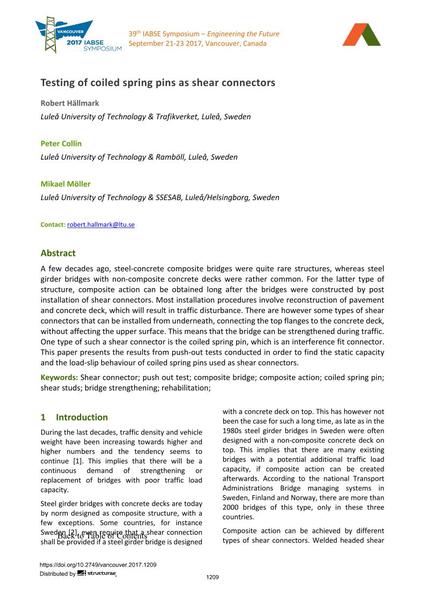Testing of coiled spring pins as shear connectors

|
|
|||||||||||
Bibliographic Details
| Author(s): |
Robert Hällmark
Peter Collin (Luleå University of Technology & Ramböll, Luleå, Sweden) Mikael Möller (Luleå University of Technology & SSESAB, Luleå/Helsingborg, Sweden) |
||||
|---|---|---|---|---|---|
| Medium: | conference paper | ||||
| Language(s): | English | ||||
| Conference: | IABSE Symposium: Engineering the Future, Vancouver, Canada, 21-23 September 2017 | ||||
| Published in: | IABSE Symposium Vancouver 2017 | ||||
|
|||||
| Page(s): | 1209-1216 | ||||
| Total no. of pages: | 8 | ||||
| Year: | 2017 | ||||
| DOI: | 10.2749/vancouver.2017.1209 | ||||
| Abstract: |
A few decades ago, steel-concrete composite bridges were quite rare structures, whereas steel girder bridges with non-composite concrete decks were rather common. For the latter type of structure, composite action can be obtained long after the bridges were constructed by post installation of shear connectors. Most installation procedures involve reconstruction of pavement and concrete deck, which will result in traffic disturbance. There are however some types of shear connectors that can be installed from underneath, connecting the top flanges to the concrete deck, without affecting the upper surface. This means that the bridge can be strengthened during traffic. One type of such a shear connector is the coiled spring pin, which is an interference fit connector. This paper presents the results from push-out tests conducted in order to find the static capacity and the load-slip behaviour of coiled spring pins used as shear connectors. |
||||
| Keywords: |
composite bridge rehabilitation shear connector bridge strengthening composite action shear studs coiled spring pin push out test
|
||||
